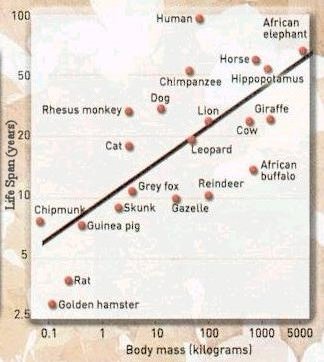
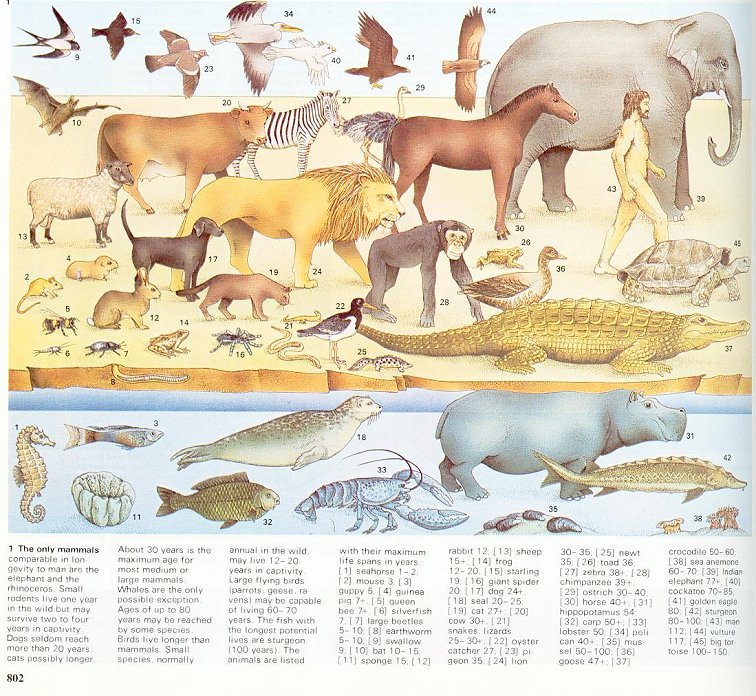
 |
 |
shows that there is considerable deviation from a linear relationship, and Figure 02 displays many exceptions including the primitive sea anemone, which can survive up to 70 years. Signs of senility, or extreme old age, are seldom seen in the wild. Animals living under natural conditions rarely approach their maximum possible age because of very high death rates due to infant mortality, diseases, predators, bad weather, accidents, or competition for food and shelter. For this reason, most of the reliable information about the length of the life span comes from the zoos. |
Figure 01 Life Span[view large image] |
Figure 02 Bio-longevity[view large image] |
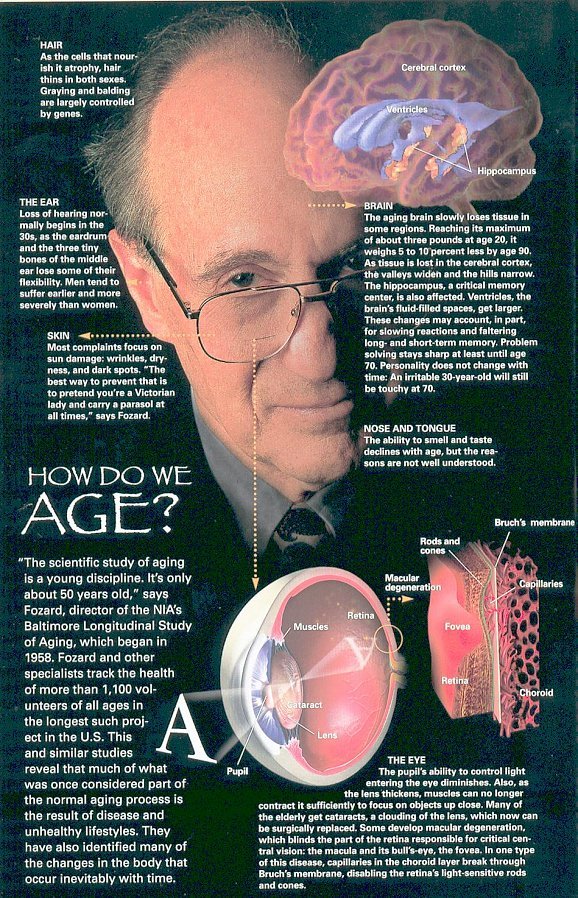 |
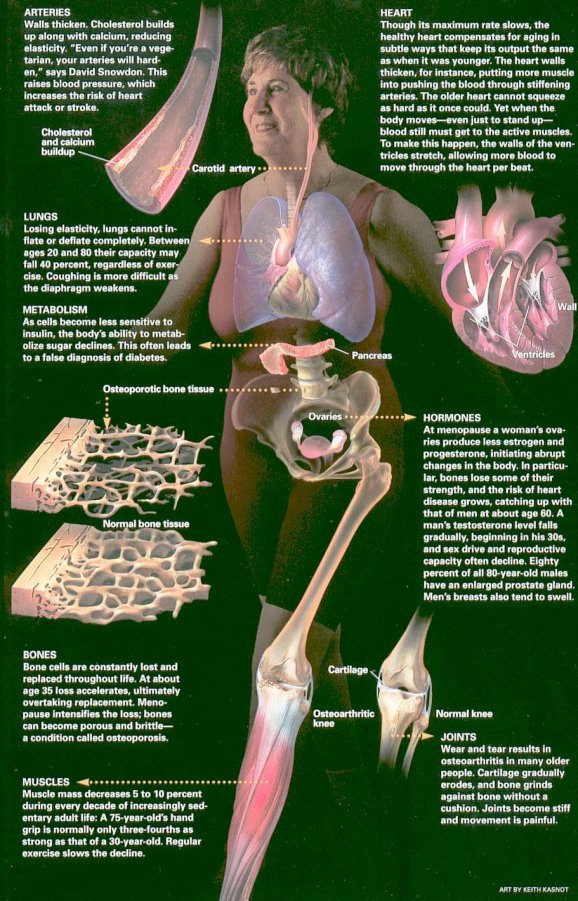 |
The ageing process occurs over all the body and for everyone, but the pace may be different depending on the type of organ or individual. Certain cells in our tissues simply stop working after a while. When enough tissue is rendered dysfunctional, we come face to face with the debilitation of ageing. However, these cell deaths do not happen all at the same time. Some tissues remain viable for many decades, some wear out rather quickly. And ageing does not occur in the same way in every human being. It turns out that people's lifestyles also has additional influence on ageing. Table 01 lists the ageing symptoms for a few selected organs and biological functions to illustrate "how we age". More details can be found in Figure 03 and 04 for some of the organs. |
Figure 03 Symptoms 1 [view large image] |
Figure 04 Symptoms 2 [view large image] |
| Organ or System |
Ageing Symptoms |
|---|---|
| Arteries | Cholesterol and calcium buildup, walls thicken, arteries harden, high blood pressure, risk of heart attack. |
| Bladder | Connective tissue weaken, lower capacity to store urine, and reduced efficiency of emptying content. |
| Blood | White blood cell and red blood cell count decrease. |
| Body Weight | Weight declines between age 55 and 75, due mostly to loss of lean tissue, muscle mass, water, and bone. |
| Bones | Loss of bone cells accelerates at about age 35, bones become porous and brittle in the demineralizing process. Osteoporosis is common in women. |
| Brain | Gradual loss of brain tissue ( 5-10% by age 90), slow reaction, faltering memory, insomnia. |
| Ear | Gradual loss of the ability to hear higher frequencies, starting around age 30; hair grows in auditory canal. |
| Eye | More far-sighted, problem with focusing, difficulty in adjusting to light intensity, perception of hues altered. |
| Face | Wrinkles, facial hair, bags under the eyes, double chin, longer ears, thinning cheek. |
| Hair | Graying, thinning, balding. |
| Heart | Thickening of heart wall, gradual lose of effectiveness as a pumping machine. |
| Hormones | The level of several hormones falls with age, it may exert a controlling influence on ageing. |
| Immunity | Body's power to combat infection declines; auto-immune responses increase. |
| Joints | Cartilage becomes cracks and frays, cushioning fluid gets thinner, tendons and ligaments are less resilient. |
| Kidneys | Weight & volume of the kidneys shrink, marked reduction in the cleansing of impurities from the blood. |
| Liver | The ageing process does not affect adversely the liver. |
| Lungs | Lose elasticity and capacity (40% between ages 20 and 80), increasing difficulty to oxygenate blood. |
| Metabolism | Ability to metabolize sugar decreases with age, reduction of food intake may prolong life. |
| Muscles | Loss of muscular mass, partly due to un-use, other causes include loss of blood flow and energy supply. |
| Nose | Ability to smell declines after age 65, amount of reduction varies widely between individuals. |
| Prostate | Reduction in semen making after 60, enlargement in size may cause difficulty to urinate. |
| Reaction Time | Mental and physical responses to specific stimuli become slower. |
| Reproductive System |
Women go through menopause at ages of 45 - 50, reduced level of estrogen affects the whole body. Men's reproductive change with age is more like a reduction than a cessation. |
| Skin | Wrinkles, dryness, dark spots. |
| Thermoregulation | Capacity for coping with changes in environmental temperature becomes impaired. |
| Tongue | Sense of taste loses only gradually with age, with equal reduction of all flavors. |
| Men | Women | |
|---|---|---|
| 01 | Heart disease | Heart disease |
| 02 | Cancer | Cancer |
| 03 | Accidents | Stroke |
| 04 | Stroke | Chronic obstructive lung disease |
| 05 | Chronic obstructive lung disease | Diabetes |
| 06 | Diabetes | Alzheimer's disease |
| 07 | Pneumonia and influenze | Accidents |
| 08 | Suicide | Pneumonia and influenze |
| 09 | Kidney disease | Kidney disease |
| 10 | Live disease | Blood infections |
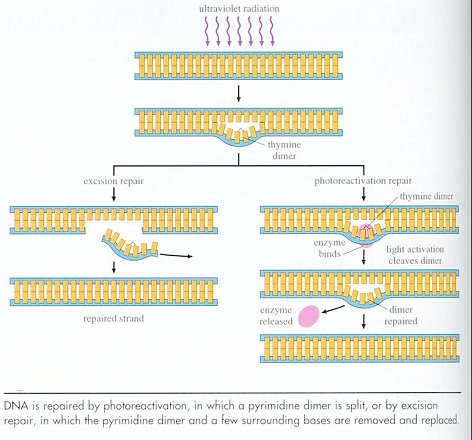 |
|
Figure 05 DNA Repair[view large image] |
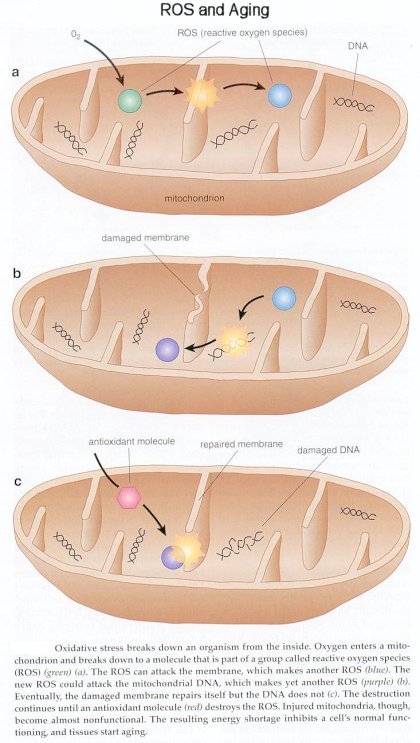 |
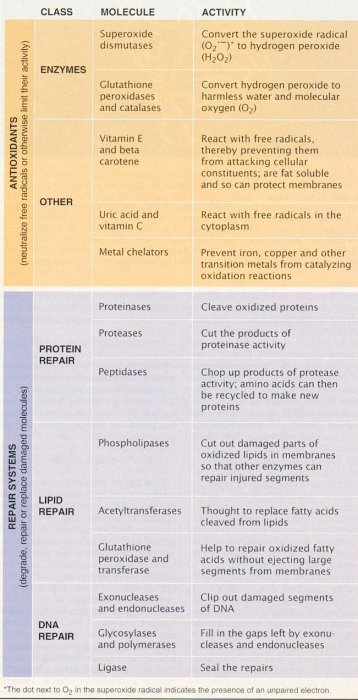 |
the result of the breakdown in the cellular safety nets - not enough anti-oxidants are produced naturally. In addition, modern life has enormously increased the number of toxic free-radicals introduced into our bodies every day from the surrounding environment. The most significant sources of excess free-radicals are dietary or environmental. Dietary sources are usually fats, either rancid or hydrogenated fats, and fats that have been heated to high temperatures during cooking. Environmental pollutants include automobile exhaust, cigarette smoke and numerous other chemicals, physical exercise, stress, and radiation. Table 03 summarizes the variety of defenses prevent or repair molecular damage caused by free radicals, but as a group they are thought to be imperfect. Some evidence indicates that certain of the defenses also become less effective over time (ageing). New study found that in the course of ageing, certain people are more vulnerable than others to age-related |
Figure 06 ROS |
Table 03 Defenses |
damage from ROS, and genes related to memory and learning appear to be more vulnerable than other genes. Further research is needed to identify the causes. |
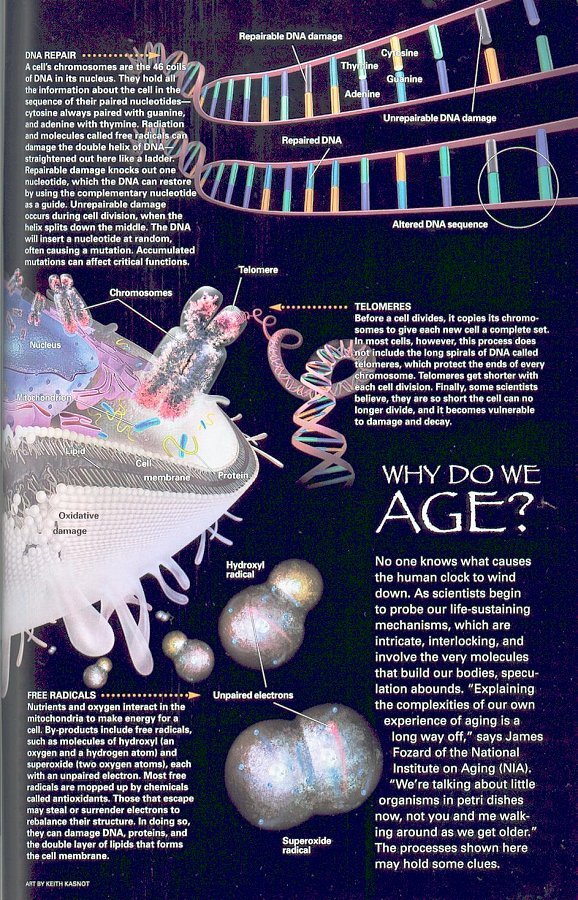 |
|
Figure 07 Telomere etc. |
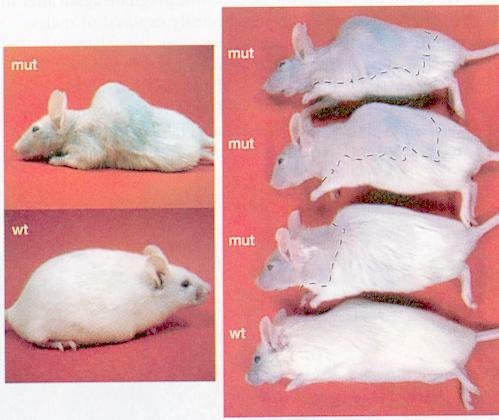 |
mtDNA polymerase with poor proof-reading activity, and hence an enhanced mutation rate. These mice develop signs of premature ageing and die aged about a year instead of 2-3 years. The finding strongly support the idea that mutations in mitochondrial DNA can cause at least some features resembling ageing instead of just correlative (the manifestations of growing old). Figure 08 compares the mutating mice (mut) with the littermate wild-type (wt) at the age of ~ 40-45 weeks. It shows the mtDNA-mutator mice with reduced body size, kyphosis (curving of the spine), reduced hair density and different stages of alopecia (baldness) - delineated by dashed line (from bottom to top). |
Figure 08 Mutating Mice [view large image] |
New study on human have linked unhealthy mitochondria to Alzheimer's, Parkinson's, type 2 diabetes and other degenerative diseases. |
 |
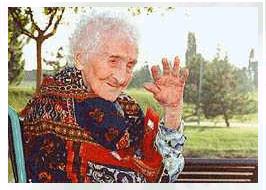 |
France's Jeanne Calment (see Figure 10), who lived to be 122 years and 164 days old. Longevity ran in her family. Calment's mother lived until she was 86 and her father until he was 94. Her personal outlook of life may also contribute; it is said that she was immune to stress. She was once quoted: "If you can't do anything about it, don't worry about it." |
Figure 09 Fountain of Youth [view large image] |
Figure 10 Jeanne Calment [view large image] |
 |
|
Figure 11 Vegetables [view large image] |
a role in preventing certain cancers. Blueberries and bilberries are two of the best antioxidant foods you can buy -- and are very rich in phytonutrients. |
| Food | Link to the Genes | Specific Gene | Function of the Gene | Long-term Effect |
|---|---|---|---|---|
| Green Tea | Helps to inhibit genes that fuel breast cancer | HER-2 | Triggers growth signals in cells | Slow HER-2 signaling in tumors |
| Broccoli | Boosts genes that protect against heart disease | GST | Produces the body's master antioxidant - glutathione | The additional glutathione helps keep arteries healthy |
| Soybeans | Affect 123 genes in- volved in prostate cancer | p53 | Kill mutant cells | Increase activity of the p53 gene to block tumor formation |
| Turmeric (a curry ingredient) | Suppresses genes that bump up inflammation | Cox-2 | Makes inflammatory compounds | Help to ward off heart disease, colon cancer and Alzheimer's |
 |
of aging and lifestyle defects; cancer patients are usually a bright yellow, a pH of 4.5, especially when the disease becomes terminal. You can test the pH level of your saliva or urine at home with pH paper strips. Figure 12b shows the colour index for standard pH paper corresponding to the pH scale. An acidic pH can occur from, an acid forming diet, emotional stress, toxic overload, and/or immune reactions or any process that deprives the cells of oxygen and other nutrients. The body will try to compensate for acidic pH by using alkaline minerals. If the diet does not contain enough minerals to compensate, a build up of acids in the cells will occur. The body has three mechanisms for the maintenance of normal |
Figure 12a pH Scale [view large image] |
acid-base balance: |
 |
exhausted. Virtually all degenerative diseases, including cancer, heart disease, osteoporosis, arthritis, kidney and gall stones, and tooth decay are associated with excess acidity in the body. One of the solutions is to take foods that cause the blood to become alkaline. For example, almost all vegetables (except peppers, beets), and practically all fruits (except blueberries, plums, prunes, cranberries) are alkaline. Some dietitians recommand as much as 80% of the diet to be alkalizing foods. Many websites post complete listing on alkaline and acidic foods (see for |
Figure 12b Colour Index for pH Paper |
example: http://www.essense-of-life.com/info/foodchart.htm). |
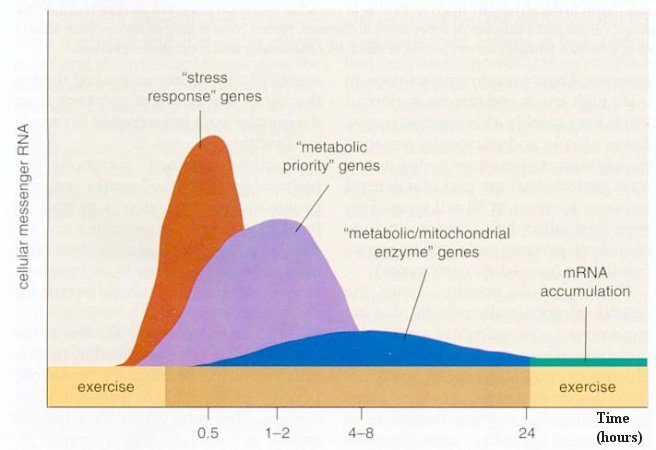 |
Recently in 2004, it is found that the activity level of skeletal muscle modulates a range of genes, which produce dramatic molecular changes - and keep us healthy. The skeletal muscle is the largest single tissue type in the human body. We have more than 640 muscles, accounting for between 30 and 40 precent of total body weight. It uses as much as 25% of the energy consumed by the body at rest. Skeletal muscle continuously adjusts its composition to meet the acute or chronic demands placed on it - a process called plasticity. It has been shown that one-third of skeletal muscle in an immobilized limb can disappear within weeks. It is as if |
Figure 12c Exercise and Gene Expression [view large image] |
skeletal muscle recognizes that it is not needed and "remodels" itself into weak muscle. In order for skeletal muscle to exhibit plasticity, specific genes in the muscle sense the change in its usage and respond by altering the quantities of proteins that |
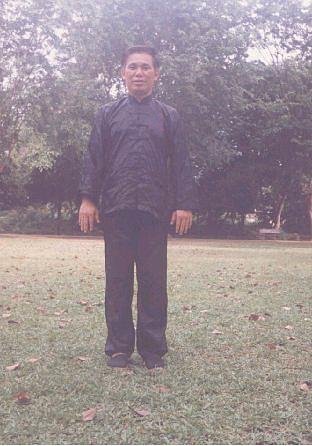 |
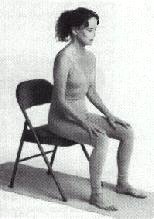 |
Meditation has been practised in the East for thousand years and emerges in Western culture lately in various forms. If the mystical layers are removed from its traditional package, the net effect becomes very useful for reducing stress. The switch from "fight and flight" mode to maintenance mode would enhance greatly the health of everyone especially the elderly. Figure 13 and 14 show a standing and a sitting posture for the "simplified" meditation. It is not important whether the practitioner is standing, sitting or lying down. The most important requirement is to relax both the mind and the body. Initially it may be necessary to find a quiet place to minimize distraction. Eventually the mind learns to detach from the noise and other external stimuli. The effect also shows up in daily |
Figure 13 Meditation, Standing |
Figure 14 Meditation, Sitting |
life. For example, there would be more tolerant toward alien beliefs, obnoxious behaviors, and other unpleasant happenings; it would also improve mental alertness and physical fitness. |